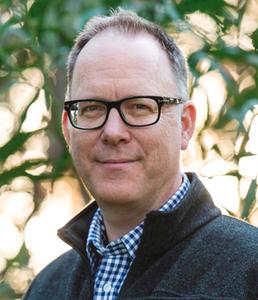 |
|
| photo: Wendy McDougall | |
Garth Nix has been a full-time writer since 2001, but has also worked as a literary agent, marketing consultant, book editor, book publicist, book sales rep, bookseller and served in the Australian Army Reserve. His bestselling books include the Old Kingdom fantasy series; Shade's Children and A Confusion of Princes; and a Regency romance with magic, Newt's Emerald. More than five million copies of his books have been sold around the world, in 42 languages. Angel Mage, his newest YA novel, will be published by Katherine Tegan Books in October.
This is your longest book to date. Why is this particular work heftier than your others? Did it feel as if the needs of the story required the near-600 pages?
It's only just my longest, Lirael comes very close. With Angel Mage, I am telling a story with essentially five main characters, whose stories intertwine and grow together, and this needed a little more space than my other books. Of course, in the general field of epic fantasy, it is no more than medium-sized!
What is it about The Three Musketeers that inspired you to write Angel Mage?
I think it is the same impulse that inspires rereading favorite books, when you want to experience them over and over again, to reenter that world and live in it. For me, I wanted to create a similar feel of adventure and derring-do, while not actually being a retelling or version of the same story.
Why angels and a young adult audience?
This speaks to the heart of the eternal question "what is a YA novel?" To me, The Three Musketeers is a YA novel, because my preferred definition of YA books is that they are essentially adult novels that have particular appeal to teenagers and up. I first read The Three Musketeers at 12 or 13, and have loved and reread it ever since (though you do need a good translation, Lowell Bair's in Bantam Classics is a good one). As for angels, it was an instinctual thing, as I thought about what kind or kinds of magic would fit in with a 17th-century alternative European world. Also, I am deeply fascinated with angels.
How did you name all of the angels? There is something about all of the names that feels (to this English-speaker) very, well, angelic. How did you find that vibe?
I did make up the angel names, but drew very much on existing names and usage, including the Hebrew suffixes of -iel and -ael. Most angel names we know today were in fact made up in the medieval era by many different writers--there are very few named in biblical texts.
A thing that particularly struck me was how intricate the power structures and hierarchies in this work are. How did you develop those?
Much of that is historical or adapted from real history. I am a great reader of history of all kinds, from fairly heavy academic tomes to popular histories and biographies, and historical fiction. I tend to mentally collect small details that will come in handy in my own fiction.
And the details in clothing, too! One character wears red heels to denote her title, correct? There's also a fair amount of face paint.
Red heels were an historical thing, to denote nobility. There is a long history in many different cultures of sumptuary laws that set out what people from different social classes could wear or not. Face paint was also very prevalent in the 17th century--the white face paint apparently poisoned many people because it was made of lead. I adapted that to crimson paint for the Cardinal simply because it would be different and also scary.
The thing I loved the most about this book was how regularly I was forced to confront my own assumed white-male default, especially in positions of power. Cardinal, Captain, Captain-General and so on are all women, mostly women of color. And all are well-developed individuals with their own plans and desires, leading countries or actively working to destroy them--I loved that the women are the heroes, the villains and everything in between. To the point: why a tribute to such a white male-heavy book? Did you find yourself fighting your own white male default as you wrote?
It's interesting, because hardly anyone would notice if all those supporting characters were men, that would just be the default of centuries continued. Having most of the cast of the powerful and important be women and people of color shouldn't be significant. In my own small way, I'm trying to break an age-old mindset and expectation in fiction that it will be all male, to reflect the modern realization that gender and skin color should be irrelevant to employment, position and power. I set out long ago to fight my own white male default, in the Old Kingdom books and elsewhere, but of course I have needed help along the way to break me out of many ingrained perceptions and privileges, and it is an ongoing process.
Is there anything else you'd like to tell Shelf readers?
After working very hard myself to work out how to describe the book, I think my efforts were superseded by my British publicist Stevie Finegan, who nailed it in a tweet: "Did you always want the three musketeers to have MAGIC and KICKASS FEMALE CHARACTERS?" --Siân Gaetano, children's and YA editor, Shelf Awareness

